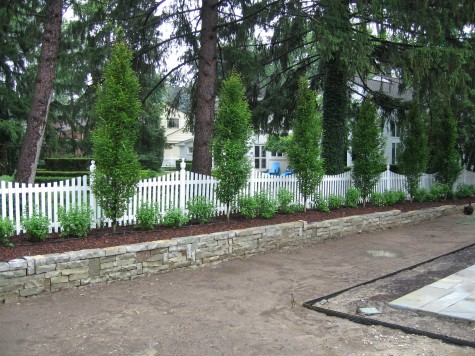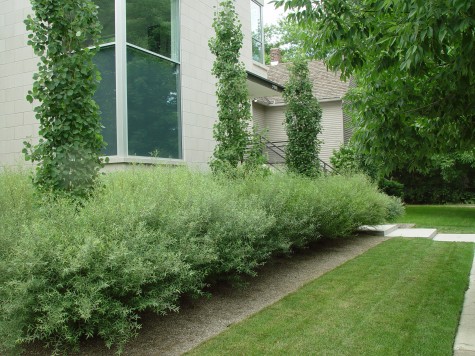
Any landscape is predicated on a finite amount of space. A property could be described by a certain amount of square footage on the ground plane. A landscape is comprised of lots of different elements, the largest of which would be the sky. Next up, the trees. I suppose a small urban property could be forested like woodland, but that assumes the gardener has only one use in mind for their landscape. Fortunately, trees come in all sizes and shapes. A number of trees have a fastigiate, or columnar form. This means just what the word implies. The foliage or needles grow naturally in a column. A tree with a restricted spread is a great choice for small gardens, for gardens that ask for screening, and for gardens asking for natural ornament. Years ago, this side garden was in full view of a neighboring house. Today all that remains of that view is a chimney. The arrangement of pairs of columnar hornbeams have created a natural pergola that is home to a shady seating area.
 My first visit to this property immediately brought the idea of columnar trees to mind. The back yard is very small, and adjacent properties very close. The prominent feature of the yard-a beautifully constructed wall. The soil had been mounded up against the wall, and boxwood had been planted against its base. In the front of the bed, a collection of perennials. The boxwood and perennials obscured rather than featured the wall, nor could they possibly provide screening from a neighboring house. The rear yard screen of hemlocks had grown thin, and was very wide at the bottom where no screening was really needed.
My first visit to this property immediately brought the idea of columnar trees to mind. The back yard is very small, and adjacent properties very close. The prominent feature of the yard-a beautifully constructed wall. The soil had been mounded up against the wall, and boxwood had been planted against its base. In the front of the bed, a collection of perennials. The boxwood and perennials obscured rather than featured the wall, nor could they possibly provide screening from a neighboring house. The rear yard screen of hemlocks had grown thin, and was very wide at the bottom where no screening was really needed.
 These columnar Bowhall maples will eventually completely screen the neighbor’s garage wall from view. Lowering the grade meant much more of the wall was available to view. The hemlocks were replaced with Thuja Nigra, an arborvitae that grows narrow and tall. A very small yard is now completely private, given the planting of fastigiate trees. The maples only occupy the air space; their pole-like trunks take up no room whatsoever. The arborvitae are narrow at the bottom as well as the top. This helps to make a very small space feel spacious.
These columnar Bowhall maples will eventually completely screen the neighbor’s garage wall from view. Lowering the grade meant much more of the wall was available to view. The hemlocks were replaced with Thuja Nigra, an arborvitae that grows narrow and tall. A very small yard is now completely private, given the planting of fastigiate trees. The maples only occupy the air space; their pole-like trunks take up no room whatsoever. The arborvitae are narrow at the bottom as well as the top. This helps to make a very small space feel spacious.
 This back yard sloped steeply towards the foundation of the house; water in the basement was a problem. A retaining wall permitted the soil at ground level to be graded away from the house. The top of the wall was planted with hornbeams spaced at 12 feet apart; they will grow together faster than you think. Carpinus fastigiata is naturally broadly egg shaped, but it is quite tolerant of pruning. The hydrangeas will make the wait for the trees to grow a little more tolerable. It will be interesting to see what direction the client wants to take with pruning. They have time to sort that out. The wall also gave the trees a little leg up, screening out the neighboring property.
This back yard sloped steeply towards the foundation of the house; water in the basement was a problem. A retaining wall permitted the soil at ground level to be graded away from the house. The top of the wall was planted with hornbeams spaced at 12 feet apart; they will grow together faster than you think. Carpinus fastigiata is naturally broadly egg shaped, but it is quite tolerant of pruning. The hydrangeas will make the wait for the trees to grow a little more tolerable. It will be interesting to see what direction the client wants to take with pruning. They have time to sort that out. The wall also gave the trees a little leg up, screening out the neighboring property.
 Arborvitae have a naturally columnar shape, but they also adapt quite well to closer pruning. This landscape called for a vertical element which would not shade the surrounding plants. A once yearly pruning is all it needs to keep it in shape.
Arborvitae have a naturally columnar shape, but they also adapt quite well to closer pruning. This landscape called for a vertical element which would not shade the surrounding plants. A once yearly pruning is all it needs to keep it in shape.
 This landscape features both pruned and unpruned arborvitae. The pruned cylindrical shapes are very interesting and sculptural. Pruning any tree or evergreen should be undertaken over time. It has taken my palabin lilacs on standard 2 years to recover from the shock of my pollarding fit.
This landscape features both pruned and unpruned arborvitae. The pruned cylindrical shapes are very interesting and sculptural. Pruning any tree or evergreen should be undertaken over time. It has taken my palabin lilacs on standard 2 years to recover from the shock of my pollarding fit.
 There are those trees that are not particularly columnar by nature, but they are amenable to pruning. The hybrid magnolia “Ivory Chalice”, a cross between magnolia acuminata, and Magnolia denudata, has been priuned to stay within the confines of this very narrow space along a driveway. They have been happy here for over 10 years.
There are those trees that are not particularly columnar by nature, but they are amenable to pruning. The hybrid magnolia “Ivory Chalice”, a cross between magnolia acuminata, and Magnolia denudata, has been priuned to stay within the confines of this very narrow space along a driveway. They have been happy here for over 10 years.
 Populus tremuloides erecta , or Swedish columnar poplar, is a loosely growing columnar tree that will eventually provide some screening for the giant windows of this contemporary home. The rounded and scalloped leaves flutter in the breeze just like any other popple, and the fall color is great. This tree may occasionaly have a branch that falls out-a little pruning will put that to right. Even older trees are not much wider than 5 or 6 feet.
Populus tremuloides erecta , or Swedish columnar poplar, is a loosely growing columnar tree that will eventually provide some screening for the giant windows of this contemporary home. The rounded and scalloped leaves flutter in the breeze just like any other popple, and the fall color is great. This tree may occasionaly have a branch that falls out-a little pruning will put that to right. Even older trees are not much wider than 5 or 6 feet.
Of course the queen bee of columnar trees has to be the fastigiate European green beech. Properly cared for, as these are, they make a very strong vertical statement.
 Once these trees reach the roof line of the house, they could be pruned flat. Age will only improve these fine trees.
Once these trees reach the roof line of the house, they could be pruned flat. Age will only improve these fine trees.









